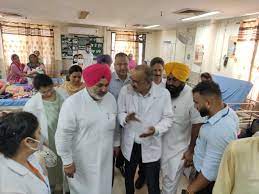Particularly in rural and urban areas, there is a severe dearth of medical facilities and specialists, which poses serious problems to Punjab’s healthcare system. The Union health ministry has released a paper titled Health Dynamics of India: Infrastructure and Human Resources 2022-23, which highlights the state’s dismal circumstances as of March 31, 2023.
With 12.9 million people living in metropolitan areas, there are only 124 primary health centers (PHCs) compared to the necessary 258—a 52% shortage. With an estimated 17.9 million people living in rural areas, there are 2,857 sub-centres compared to the 3,575 that are required, resulting in a 20% shortfall. Furthermore, only 397 of the 595 PHCs that are needed in rural areas are now in operation, leaving a 33% deficit. There is a 43% shortfall in community health centers (CHCs) as there are only 84 available out of the 148 that are needed.
The shortage of medical professionals, particularly specialty physicians, exacerbates these infrastructure deficiencies. With 336 sanctioned posts and only 119 specialists hired in urban CHCs, there is a vacancy rate of more than 64%. Likewise, urban PHCs have 161 medical officers, while they require 236, which means that there is a 32% vacancy. In rural areas, where there are just 55 specialists working in CHCs out of the required 336, the deficit is significantly worse. Rural CHC expert job openings have increased over time, from 167 in 2005 to 243 in 2023—a 45% gain.
Only 17 pediatricians, 18 surgeons, and 12 obstetricians work in rural CHCs, indicating the underrepresentation of these vital specialties. The quality of healthcare is jeopardized by these openings, particularly in rural areas where the demand is greatest.
Inadequate infrastructure makes the issue worse. Only 46% of rural PHCs offer 24-hour services, and many of them are devoid of necessities like electricity and water. Few sub-centers have adequate restrooms, and many do not have accommodations for staff members such as auxiliary nursing midwives (ANMs). The state’s capacity to provide its citizens with high-quality healthcare is hampered by its poor infrastructure.
The lack of specialized physicians and medical facilities remains a significant barrier to Punjab’s healthcare system, despite government efforts to ameliorate the situation. This is especially true in rural areas where the need for services is greatest.
SOURCE :
TIMES OF INDIA








